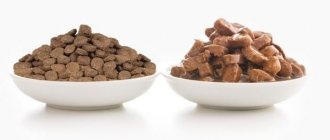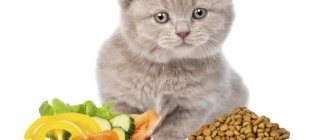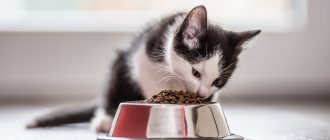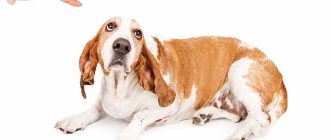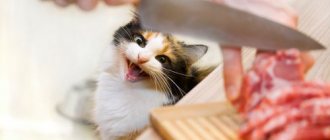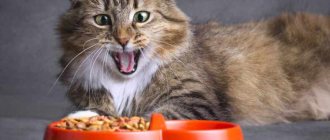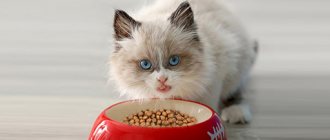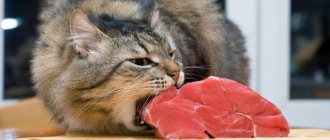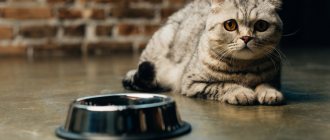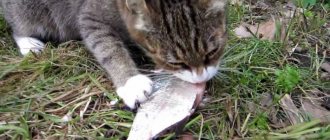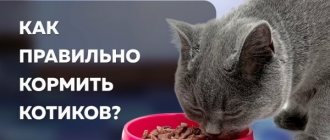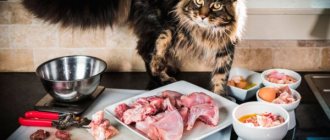Any owner who decides to have an animal in the house immediately asks the question: what to feed it? Everyone is looking for answers to it in their own way, trying out different methods and various combinations, but a significant indicator that the diet is balanced is the excellent health and activity of the furry pet.
For those owners who decide to stick to an industrially produced cat menu, veterinarians advise using both dry and wet high-quality food from the same manufacturer and brand. But it often happens that a cat completely refuses to eat crackers, demanding only pates or pouches for lunch. But is it possible to feed a cat only wet food, that’s the dilemma.
Wet food for cats: advantages
When a four-legged family member eats dry food, you need to carefully ensure that he drinks a lot of moisture. And if a problem with water balance is discovered, then new “dishes” with various flavoring additives in the form of wet food need to be introduced into his diet.
This diet is well digestible, resembles natural food, since it contains whole pieces of meat or fish, and has a fixed volume, which will help limit the portion of an eternally hungry friend who is prone to overeating.
What not to do with mixed feeding
As you already understand, mixed feeding is not just adding wet food to dry food or vice versa. It involves creating a balanced diet, in which both products serve as an organic and complete element.
If you have carefully selected wet food and dry food, and believe me, this is not an easy task with all the variety of choices, then you should not change brands and indulge in unnecessary experiments. Of course, sometimes you want to pamper your cat with something tasty, but it’s better to buy him a treat than to grab the first bag he likes and replace such a carefully selected product with it, disrupting your pet’s diet. This won't lead to anything good.
Why you shouldn't feed cats only wet food
Considering wet food more useful, many owners are guided by the statistics of cat diseases of food intolerance and kidney disease. But this statement is only true for low quality wet additives. But even if you purchase high-quality varieties, you need to take into account that feeding your pet only wet food is unsafe.
Cats are predators by nature and are accustomed to tearing off pieces of game with their teeth. This method of nutrition solves the problem of cleaning the fangs from plaque and protects them from the formation of stone. Therefore, when answering the question whether it is possible to feed a cat only wet food, it is important to know that such food can provoke the development of diseases associated with problems with gums and teeth, an unpleasant odor from the mouth and, as a result, diseases of the stomach and intestines.
Therefore, wet food should be used as a pleasant “yummy” in order to pamper your cat, and dry and wet food should be alternated, giving it at different feedings, so that each of them performs its functions in turn.
Natural characteristics of cats
Cats, being predators by nature, are designed in such a way that for the normal functioning of all body systems they need protein food. Meat, bones and entrails of captured animals are the only source of food for the wild brothers of domestic cats.
The latter, who have been living side by side with humans for thousands of years, will not experience a lack of nutrients, taking advantage of the fruits of their hunt for mice and rats.
Food offered to cats should contain 70-80% meat ingredients.
Raw meat is a supplier of energy, responsible for cell growth, the state of the immune system, and is responsible for reproductive and other functions of the body. Animal protein contains essential amino acids that cats cannot synthesize on their own.
Taurine is an amino acid that cats do not produce in their bodies like some others, and it only comes from meat products. Taurine is responsible for vision and cardiac activity, helps in digestion processes. Taurine is added artificially to industrially produced cat food.
Which cats can only be fed wet food?
Despite generally accepted recommendations, there are cases when, for health reasons, a furry patient is prescribed an exclusively wet diet. These are situations where an animal has gum disease, and solid food can further injure them, increasing the risk of tooth loss.
Soft food is prescribed to weakened cats, as well as after surgical operations, in order to conserve the animal’s strength and direct it to a speedy recovery. Cats are fed only wet food also during periods of exacerbation of digestive problems or in case of dehydration. Well, and, of course, the group of such pets includes babies aged 3–6 weeks, who are still unable to chew hard pieces, and they no longer have enough mother’s milk.
General information
The popularity of industrial cat food is understandable - owners have no time to prepare food for their pets. Ready-made food can be placed in a bowl and stored for a long time - this is undoubtedly convenient. Striving for convenience, do not forget about the needs of the cat, because its health depends on a balanced diet!
You should not feed your pet with economy class food . These products are made from cereals and do not contain meat or vitamins. Simply put, cheap food is a useless filler for the stomach. In addition, economy class products contain salts and preservatives, which contribute to the development of urolithiasis.
Premium and super-premium classes are considered optimal for everyday feeding. However, you should not blindly trust the inscriptions on the packs! Read the composition of the product, only it will show the true value of the food. Some manufacturers believe that food containing 70% grains is healthy, but this is far from true. Holistic class foods are considered the most natural, but they also have the highest price.
Packed rations or canned food?
There is still fierce debate on this topic among animal lovers, with no end in sight. However, there is no clear answer to this question.
Dry food
Oddly enough, dry food is not the worst option. In any case, it is definitely no worse and much safer than food waste, which is full of spices and salt, which do not have the best effect on the baby’s health. It is only important to understand that the animal’s daily diet should consist of at least 70% wet food. This requirement applies to kittens under six months of age. From six months of age to one year, the ratio is adjusted to 50/50. If you buy good food, then there is nothing wrong with using it.
Wet food
Again, contrary to the common misconception that wet food is the best option for feeding kittens, in practice everything is not so clear-cut. It is better only if the product belongs to the “Premium” or “Super-premium” class. Cheap wet food is frankly dangerous for the health of kittens, since there is simply nothing useful in it. At best, it is a mixture of ground sinews and hooves with gelatin and cereals.
You can feed your kitten any food, but only high-quality food.
It would seem a banal rule, but owners often forget about it. Simply put, the kitten will be much healthier if you give it a good dry diet, rather than cheap canned food that does not and never has had meat.
Oh is also not a panacea. If a kitten is underfed or, on the contrary, overfed, nothing worthwhile will grow out of it. In order for the pet to be truly healthy and vigorous, in any case it would not hurt the owner to consult a veterinarian.
How to offer kitten food to an adult pet?
If you decide that kitten food will be beneficial for your adult cat, introduce it into the diet gradually. Due to the high calorie content of the product, a sudden transition to a new food can cause problems in the animal’s digestive system.
The best way to switch to a new diet is to add some kitten food to your pet's usual food. After two weeks, the portion of “children’s” food should be increased, and the portion of “adult” food should be reduced. These steps must be taken until your furry friend completely switches to “baby food”.
Is it possible to soak dry food?
Soaking food helps to feed an animal accustomed to wet spiders, preferring a certain type of “crackers”, but not having the opportunity to eat them in their original form (trauma to the gums, jaw, loss of teeth, etc.). Warm water is added to the granules; in 15-20 minutes the food will soften, absorbing moisture.
It will not reach the state of puree; to force-feed the cat with a syringe, you will have to grind it with a blender. Fresh food with the addition of water does not lose its nutritional qualities, animals like it, and it is not worth storing it in the refrigerator for more than 12 hours. Such food is a breeding ground for bacteria.
Be sure to read:
Is it possible to feed a cat dry food and natural food at the same time: pros and cons, which is better?
Nutrient content
If we compare the compositions of food from the same line, we will see that products labeled Kitten are characterized by greater nutritional value. They contain the following content:
- protein;
- vitamins;
- minerals;
- fat
This is necessary to support the growth and development of a young body. In addition, due to the increased fat content, the food is quite high in calories. Consequently, it provides more energy, which nimble kids spend very actively.
Types of industrial rations
The modern market for animal products offers several types of wet production diets. They differ in their composition and price:
- Holistics are the most expensive product, characterized by excellent quality. The composition contains exclusively natural products, the source of protein is meat. The products contain vitamins and minerals that satisfy the daily needs of a growing body. The disadvantage is the high price, not sold in all stores.
- Super-premium - they are cheaper than holistic ones, but they also have a natural and balanced composition, including useful components.
- Premium is a high-quality food enriched with vitamins and minerals, containing, in addition to meat and vegetables, seaweed and fruits.
- Economy - a budget option. Low cost results in appropriate quality. The composition may contain preservatives, thickeners, flavor enhancers, flavorings, and chemical additives, which often cause indigestion and allergic reactions in kittens.
Owners of kittens are advised to immediately make a choice, taking into account their financial capabilities. Subsequently switching from expensive to cheap brands with preservatives in their composition can negatively affect the health of the animal.
Basic rules for feeding kittens
The kitten still has a poorly developed sense of proportion, so he can eat not only when he is hungry, but also if he is bored. Therefore, the frequency of feeding should be controlled by pet owners. To do this, you need to be guided by the principle - feed twice as often as an adult cat. On average, the frequency may be as follows:
- up to 2 months - 5-6 meals, and portions should not be large (20-30 g);
- from 2 to 4 months - 4 times a day;
- from 4 to 6 months - 3 times a day;
- From 7 months you can gradually switch to two meals a day.
Food “by age”
In addition to products made for animals with chronic problems, there are lines designed for cats of a certain age.
Typically, feed is divided into the following types:
- Baby - translated as child.
- Junior - translated as junior, between a child or a teenager.
- Young or active - translated as young or active, meaning teenage cats.
Food for kittens differs from products for adult animals in the following ways:
- High fat content - kittens need more fatty acids and amino acids, which are synthesized from fats obtained from food.
- Increased content of microelements necessary for normal bone formation.
- The Junior and Active lines often contain quite a large amount of carbohydrates, since teenage cats are playful and spend a lot of energy exploring the world.
- Increased protein content in the baby and junior lines.
It turns out that if you feed a kitten with adult food, it will have a deficiency of fatty acids, amino acids, minerals, and in some cases, proteins.
The consequences can be disastrous - retardation in growth, development, lack of weight. In the opposite situation, if an adult cat regularly receives kitten food, she will have an excess of fats, carbohydrates and minerals. Such feeding is fraught with excess weight gain and problems with bones.
When do you need to change the type or diet of feeding?
When the food suits your pet and does not cause allergies, there is no need to change it. It happens that a cat refuses to eat for a day or two, this is normal if there are no signs of illness: vomiting, fever, diarrhea. This is how the animal cleans itself.
During this period, you can offer him a different diet option; perhaps pate or pieces in jelly instead of the usual dry food will stimulate his appetite. You can change the type of food during the rehabilitation period after an illness, when a cat is feeding kittens, injuries, diseases that prevent you from chewing hard lumps.
Pets that constantly consume soft food may suffer from tartar, periodontal disease, insufficient load on the chewing muscles; predators are supposed to chew and tear. It is still advisable to alternate between foods of different consistency. The food should be changed in case of hair loss, redness of the ears and other manifestations of intolerance or allergies.
How to Calculate Portion Sizes
The recommended serving size is individual for each type of food and is indicated on the back of the package. This is due to differences in nutritional value and different percentages of moisture in the products. Additionally, the characteristics of each pet should be taken into account.
Obesity in cats is by no means a normal option and contributes to the destruction of joints and deterioration of the functioning of internal organs
In most cases, the norm has to be calculated empirically. First, the animal is offered the amount of food recommended by the manufacturer, then the change in figure is observed. If your pet’s ribs begin to protrude, the portions should be increased by 10% and continue to monitor the pet’s condition. If the ribs are difficult to palpate, and the figure begins to resemble a barrel, the norm is reduced by 10%.
